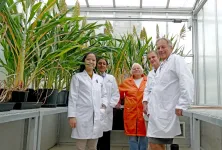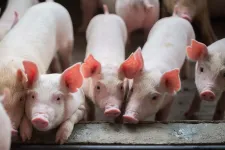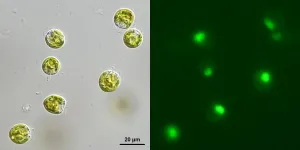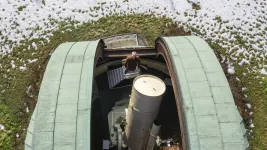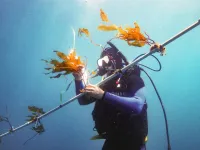Neanderthal and early modern human culture co-existed alongside older traditions for 100,000 years
Research from the University of Kent's School of Anthropology and Conservation has discovered that one of the earliest stone tool cultures, known as the Acheulean, likely persisted for tens of thousands of years longer than previously thought.
2021-03-02
(Press-News.org) The Acheulean was estimated to have died out around 200,000 years ago but the new findings suggest it may have persisted for much longer, creating over 100,000 years of overlap with more advanced technologies produced by Neanderthals and early modern humans.
The research team, led by Dr Alastair Key (Kent) alongside Dr David Roberts (Kent) and Dr Ivan Jaric (Biology Centre of the Czech Academy of Sciences), made the discovery whilst studying stone tool records from different regions across the world. Using statistical techniques new to archaeological science, the archaeologists and conservation experts were able to reconstruct the end of the Acheulean period and re-map the archaeological record.
Previously, a more rapid shift between the earlier Acheulean stone tool designs often associated with Homo heidelbergensis - the common ancestor of modern humans and Neanderthals - and more advanced 'Levallois' technologies created by early modern humans and Neanderthals, was assumed. However, the study has shed new light on the transition between these two technologies, suggesting substantial overlap between the two.
Acheulean stone tool technologies are the longest-lived cultural tradition practiced by early humans. Originating in East Africa 1.75 million years ago, handaxes and cleavers - the stone tool types which characterise the period - went on to be used across Africa, Europe and Asia by several different species of early human. Prior to this discovery, it was widely assumed that the Acheulean period ended between 300-150,000 year ago. However, the record was lacking in specific dates, and the timing of its demise has been heavily debated. The Kent and Czech team discovered that the tradition likely ended at different times around the world, varying from as early as 170,000 years ago in Sub-Saharan Africa through to as late as 57,000 years ago in Asia.
To understand when the Acheulean ended, the team collected information on different archaeological sites from around the world to find the latest known stone tool assemblages. A statistical technique known as optimal linear estimation - commonly used in conservation studies to estimate species extinctions - was used to predict how much longer the stone tool tradition continued after the most recent known sites. In effect, the technique was able to model the portion of the archaeological record yet to be discovered.
Dr Alastair Key, a Palaeolithic Archaeologist and the lead author of the study, said: 'The earliest archaeological record will always be an incomplete picture of early human behaviour, so we know that the youngest known Acheulean sites are unlikely to actually represent the final instances of these technologies being produced. By allowing us to reconstruct these missing portions of the archaeological record, this technique not only gives us a more accurate understanding of when the tradition ended, but it gives us an indication of where we can expect to find new archaeological discoveries in the future.'
Dr Roberts added: 'This technique was originally developed by myself and a colleague to date extinctions, as the last sighting of a species is unlikely to be the date when it actually became extinct. It is exciting to see it applied in a new context.'
INFORMATION:
Their research paper 'Modelling the end of the Acheulean at global and continental levels suggests widespread persistence into the Middle Palaeolithic' is published by Humanities & Social Sciences Communications. doi:10.1057/s41599-021-00735-8
ELSE PRESS RELEASES FROM THIS DATE:
2021-03-02
An impressive body of evidence published this week reveals the answer to a mystery that has puzzled plant scientists for more than 30 years: the role of the molecule suberin in the leaves of some of our most productive crops. This discovery could be the key to engineering better crops and ensuring future food security.
Highly productive crops such as sugarcane, sorghum and maize belong to the type of plants that use the more efficient C4 photosynthetic pathway to transform water, sunlight and carbon dioxide (CO2) into sugars.
Scientists have known for a long time that one of key factors that makes C4 photosynthesis more efficient is that they have the capacity to ...
2021-03-02
LOS ALAMOS, N.M., March 1, 2021-- A novel computer algorithm that could create a broadly reactive influenza vaccine for swine flu also offers a path toward a pan-influenza vaccine and possibly a pan-coronavirus vaccine as well, according to a new paper published in Nature Communications.
"This work takes us a step closer to a pan-swine flu virus vaccine," said Bette Korber, a computational biologist at Los Alamos National Laboratory and a co-author on the paper. "The hope is to eventually be prepared with an effective and rapid response if another swine flu epidemic begins to spread in humans, but this swine flu vaccine could also be useful in a veterinary setting." The immune responses to the vaccine showed very promising breadth against diverse viral variants. "The same basic principles ...
2021-03-02
Nearly everything author Malcolm Gladwell said about how information spreads in his 2000 bestseller "The Tipping Point" is wrong, according to a recent study led by UCLA professor of sociology Gabriel Rossman.
"The main point of 'The Tipping Point' is if you want your idea to spread, you find the most popular person in the center of any given network and you sell them on your idea, and then they'll sell the rest of the world on it," Rossman said.
But Rossman's latest study, recently published in Proceedings of the National Academy of Sciences, pokes holes in that widely accepted notion ...
2021-03-02
Law enforcement seizures of drugs, particularly marijuana and methamphetamine, dropped at the beginning of the COVID-19 pandemic, then increased significantly in the following months--exceeding pre-pandemic seizure rates and providing clues about the impact of the crisis on substance use, according to a new study in the journal Drug and Alcohol Dependence.
The research was conducted as part of the National Drug Early Warning System (NDEWS), which uses real-time surveillance to detect early signals of potential drug epidemics. NDEWS is led by a team of researchers at the University of Florida, New York University, and Florida Atlantic University, ...
2021-03-02
While natural disasters and economic recessions traditionally unleash an uptick in child abuse, a new study suggests that cases may have declined in the first months of the pandemic, compared with the same timeframe in previous years.
In the study, led by UCSF Benioff Children's Hospitals and Children's Mercy Kansas City, researchers tracked the number of pediatric inpatients ages 5 and under in 52 children's hospitals nationwide for the first eight months of 2020. They found a steep decline in the number of ER visits and hospital admissions, including those requiring treatment for physical abuse. This started in mid-March - around the time some states issued shelter-in-place ...
2021-03-02
A Ludwig-Maximilians-Universitaet (LMU) in Munich team has shown that slight alterations in transfer-RNA molecules (tRNAs) allow them to self-assemble into a functional unit that can replicate information exponentially. tRNAs are key elements in the evolution of early life-forms.
Life as we know it is based on a complex network of interactions, which take place at microscopic scales in biological cells, and involve thousands of distinct molecular species. In our bodies, one fundamental process is repeated countless times every day. In an operation known as replication, proteins duplicate the genetic ...
2021-03-02
New research suggests that the ability of green algae to eat bacteria is likely much more widespread than previously thought, a finding that could be crucial to environmental and climate science. The work, led by scientists at the American Museum of Natural History, Columbia University, and the University of Arizona, found that five strains of single-celled green algae consume bacteria when they are "hungry," and only when those bacteria are alive. The study is published today in The ISME Journal.
"Traditionally, we think of green algae as being purely photosynthetic organisms, producing their food by soaking in sunlight," said Eunsoo Kim, an associate curator at the American Museum of Natural History and one of the study's corresponding ...
2021-03-02
An international team led by Prof. dr habil. Andrzej Niedzielski, an astronomer from the Nicolaus Copernicus University in Torun (Poland), has discovered yet another three extrasolar planets. These planets revolve around the stars that can be called elder sisters of our Sun.
You can read about the astronomers' success in Astronomy and Astrophysics. The prestigious European journal will publish the paper: Tracking Advanced Planetary Systems (TAPAS) with HARPS-N. VII. Elder suns with low-mass companions. Apart from Prof. Andrzej Niedzielski from the NCU Institute of Astronomy, the team which worked on the discovery includes Prof. dr habil. Gracjan Maciejewski, also from the NCU Faculty of Physics, Astronomy and Informatics, Prof. Aleksander Wolszczan (Pennsylvania State ...
2021-03-02
For several years now, the biofuels that power cars, jet airplanes, ships and big trucks have come primarily from corn and other mass-produced farm crops. Researchers at USC, though, have looked to the ocean for what could be an even better biofuel crop: seaweed.
Scientists at the USC Wrigley Institute for Environmental Studies on Santa Catalina Island, working with private industry, report that a new aquaculture technique on the California coast dramatically increases kelp growth, yielding four times more biomass than natural processes. The technique employs a contraption called the "kelp elevator" ...
2021-03-02
Australia's marine World Heritage Sites are among the world's largest stores of carbon dioxide according to a new report from the United Nations, co-authored by an ECU marine science expert.
The UNESCO report found Australia's six marine World Heritage Sites hold 40 per cent of the estimated 5 billion tons of carbon dioxide stored in mangrove, seagrass and tidal marsh ecosystems within UNESCO sites.
The report quantifies the enormous amounts of so-called blue carbon absorbed and stored by those ecosystems across the world's 50 UNESCO marine World Heritage Sites.
Despite covering less ...
LAST 30 PRESS RELEASES:
[Press-News.org] Neanderthal and early modern human culture co-existed alongside older traditions for 100,000 years
Research from the University of Kent's School of Anthropology and Conservation has discovered that one of the earliest stone tool cultures, known as the Acheulean, likely persisted for tens of thousands of years longer than previously thought.
